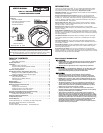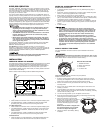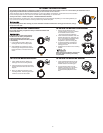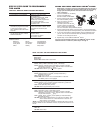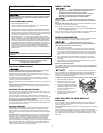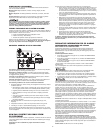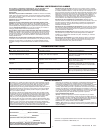
2
INSTALLATION
WHERE TO INSTALL CO ALARMS
The National Fire Protection Association (NFPA) recommends that a CO Alarm
should be centrally located outside of each separate sleeping area in the
immediate vicinity of the bedrooms. For added protection, install additional
CO Alarms in each separate bedroom, and on every level of your home.
If your bedroom hallway is longer than 40 feet (12 meters), install a CO Alarm
at BOTH ends of the hallway.
Refer to state and local building codes for additional requirements.
In a Single-level Home:
•
Install at least one CO Alarm near or within each separate sleeping area.
• For added protection, install an additional CO Alarm at least 20 feet
(6 meters) away fr
om the furnace or fuel burning heat source.
In a Multi-level Home:
• Install at least one CO Alarm near or within each separate sleeping area.
•
For added pr
otection, install at least one CO Alarm on each level of the
home. If you have a basement, install that CO Alarm at the top of the
basement stairs.
• For added protection, install an additional CO Alarm at least 20 feet
(6 meters) away from the furnace or fuel burning heat source.
In Mobile Homes:
• Install CO Alarms on inside walls ONLY. Uninsulated outside walls and
r
oofs of mobile homes often transfer heat and cold fr
om outdoors.
WHERE CO ALARMS SHOULD NOT BE INST
ALLED
Do NOT locate this CO Alar
m:
• In garages, kitchens, furnace rooms, or in any extremely dusty, dirty or
gr
easy areas.
• Closer than 15 feet (4.6 meters) from a furnace or other fuel burning heat
sour
ce, or fuel burning appliances like a water heater.
•
Within 5 feet (1.5 meters) of any cooking appliance.
• In areas where temperature is colder than 40˚ F (4˚ C) or hotter than 100˚ F
(38˚ C). These ar
eas include unconditioned crawl spaces, unfinished attics,
uninsulated or poorly insulated ceilings, porches, and garages.
•
In turbulent air, like near ceiling fans, heat vents, air conditioners, fresh air
returns, or open windows. Blowing air may prevent CO from reaching the
sensors.
• In direct sunlight.
GARAGE
SUGGESTED AREAS FOR INSTALLING ADDITIONAL CO ALARMS
BEDROOM
BEDROOM
HALL
LIVING ROOM
KITCHEN
BASEMENT
BEDROOM
REQUIRED TO MEET NFPA RECOMMENDATIONS
•
This CO Alarm is designed for use inside a single-family home
or apar
tment. It is not meant to be used in common lobbies, hall-
ways, or basements of multi-family buildings unless working CO
Alar
ms are also installed in each family living unit. CO Alarms in
common ar
eas may not be heard from inside individual family
living units.
•
This CO Alarm alone is not a suitable substitute for complete
detection systems in places which house many people, like hotels
or dor
mitories, unless a CO Alarm is also placed in each unit.
• DO NOT use this CO Alarm in warehouses, industrial or commercial
buildings, special-purpose non-r
esidential buildings, RVs, boats, or
airplanes. This CO Alar
m is specifically designed for residential
use, and may not provide adequate protection in non-residential
applications.
HOW TO INSTALL THIS ALARM
For quick installation instructions see the “Quick Installation Instructions”
included.
This CO Alar
m was designed to be mounted on the ceiling or wall. It is not
a tabletop device. You must install this device on the ceiling or wall as outlined
below. Read “Where To Install CO Alarms” before starting.
Tools you will need: pencil, drill with 3/16” (5mm) drill bit,
Phillips screwdriver, hammer.
1. Hold the mounting bracket against the ceiling (or wall) so the vertical
mounting slot is aligned in the 12 o’clock position and trace around the
inside of the mounting slots (vertical and horizontal mounting).
2. Put the unit where it won’t get covered with dust when you drill the
mounting holes.
3. Using a 3/16” (5 mm) drill bit, drill a hole through the center of the oval
outlines you traced.
4. Insert the plastic screw anchors (in the plastic bag with screws) into the
holes. Tap the screw anchors gently with a hammer, if necessary, until they
ar
e flush with the ceiling or wall.
5.
Line the mounting bracket up over the plastic scr
ew anchors.
6. Screw the mounting bracket to the ceiling or wall through the mounting
slots using the two screws provided.
7.
Attach the CO Alarm to the mounting
bracket. Line up the guides on the alarm’s
base with the guides on the mounting
bracket. When guides ar
e lined up, tur
n
the base clockwise (right) until it snaps
into place.
NOTE: Once the Alarm is snapped onto
the mounting bracket, you can rotate
the Alar
m to adjust the alignment.
8.
T
est the CO Alarm. See “W
eekly T
esting”
for details.
PARTS OF THIS CO ALARM
1 Test/Silence Button
2 Battery Compartment
3 Power LED
4 CO Alarm LED
WIRELESS OPERATION
First Alert
®
ONELINK
®
T
echnology is the easy, cost-effective way to provide
your family with whole-home safety. All ONELINK
®
Alarms communicate with
each other without wir
es or connectors. When one Alarm sounds, they all
sound. This pr
ovides your family with an earlier warning of potential danger,
and gives you more time to react.
The communication distance (range) between any two ONELINK
®
Alarms is
typically 50 feet (15 meters) inside of a home. Some features of a home, such
as the number of floors, number/size of rooms, furniture and types of building
materials used may r
educe the range of the Alarms. Examples include: sus-
pended ceilings, ductwork, large metallic appliances (refrigerators) and metal
studs. A feature of ONELINK
®
Alarms is that they operate as a mesh network.
All Alarms will r
epeat any alarm signal that is received to all other ONELINK
®
Alarms. Interference from structural conditions can be overcome by adding
additional Alarms to route the wireless signal around obstructions.
• The range and proper operation of any wireless device will vary
depending on its sur
roundings. It is very important that each
Alar
m is tested individually before and after installation to make
sure that all Alarms respond properly.
• The ONELINK
®
Alarms are not to be used outdoors or to transmit
between buildings. The Alar
ms will not communicate properly
under these conditions.
•
Metal objects and metallic wallpaper may interfere with signals
from wireless Alarms. Alarms should be tested after changes to
your home such as remodeling, moving furniture, and with metal
doors opened and closed.
Your First Alert
®
ONELINK
®
CO Alarm will automatically communicate both
potential fir
es and carbon monoxide presence with all other First Alert
®
ONELINK
®
Smoke/CO Alarms.
FCC NOTICE: This device complies with Part 15 of the FCC Rules.
Operation is subject to the following two conditions: (1) This device may not
cause harmful interference, and (2) this device must accept any interference
r
eceived, including interference that may cause undesired operation.
FCC ID: M7U5001L
Changes or modifications not expressly approved by BRK Brands, Inc.
could void the user’s authority to operate the equipment.



